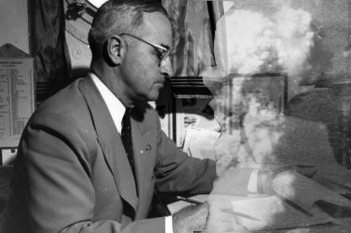Hiroshima: Truman’s Choices Revisited

Credit: HNN Staff/NARA.
The historical reconstruction of the decision to use the atomic bomb in August 1945 is an interlocking puzzle, revealing a seemingly inexorable choice to use the weapon. The United States had made a bomb and successfully tested it in July, and the scientists, generals, politicians and civilians caught up in events readily supplied the accelerating momentum to a decision: we must use it. Civilian decision-makers anxious to justify expenditures of unprecedented sums of money to develop a weapon designed to end the war offered no resistance.
The historical narrative to use the bomb largely derives from the recollections and rationales of President Harry Truman and his civilian and military advisers. For them, the stark choice came down to drop the bomb or invade the Japanese homeland and sustain a “million” American casualties -- an arbitrary, unsubstantiated figure propelled by its own momentum, with apparently no consideration of the potential for Japanese civilian casualties. A small number of scientists raised ethical and moral considerations, but their influence was of no immediate consequence.
President Truman fashioned himself as a decisive man who readily made the decision. “It isn’t polls or public opinion of the moment that counts,” he said in 1954. “It is right and wrong and leadership -- men with fortitude, honesty, and a belief in the right that makes epochs in the history of the world.” So Truman described himself and conducted himself as president, and it is how he has generally been perceived.
After he retired, Truman conducted mock press conferences at his library in Independence, Missouri with tour groups, largely composed of schoolchildren, as long as his heath permitted. Invariably, visitors would ask, “Mr. President, what was your hardest decision?” With no hesitation, he barked back, “Korea.” “But Mr. President, what about the atomic bomb?” “Atomic bomb? I used it like I would have used any artillery piece.” Truman’s defensiveness was palpable.
Were the president’s options so simple, so limited, so stark, and as obvious as he said? Truman’s aides informed him of the successful atomic explosion at Alamogordo, New Mexico, on July 18. The president and Secretary of War Henry Stimson, who oversaw the wartime Manhattan Project, agreed that the bomb would be used against Japan. Nevertheless, Truman recorded his doubts, his hesitation and his alternatives, at least before Alamogordo. One day earlier, he wrote in his diary: “I have to decide Japanese strategy -- shall we invade Japan proper or shall we bomb and blockade? That is my hardest decision to date. But I’ll make it when I have all the facts.” The successful test raised a wholly new fact.
After the war, we soon recognized the effectiveness of the aerial bombardment and naval blockade. Did -- or could -- Truman have all the statistical evidence compiled since the end of the war? Probably only in a limited way. But the claims of triumphant American air and naval commanders offered some clear language -- if anyone was listening. So, what happened to the option Truman had in mind until Alamogordo? Did the successful test of that day erase the more complicated options he had laid out the day before? Apparently.
General Curtis LeMay was well into his career of bombing civilians back to the Stone Age. The Air Force was not yet independent, but as the war neared its end, concepts of strategic bombing accelerated, resulting in the creation of the U.S. Strategic Air Force in the Pacific, with LeMay in command. B-29 firebombing raids, pushed by LeMay, decimated industrial production, with more than 60 cities largely destroyed. The infamous Tokyo fire raids in March killed more than 100,000 Japanese. Additionally, “Operation Starvation” laid down explosive mines in the inland waterways and coastal routes, effectively disrupting Japanese internal shipping.
Japan lost nearly all of its 117,000 troops defending Okinawa in June; after that, kamikaze attacks on American naval vessels abated. American submarines effectively halted all shipping of men and supplies from the remaining Japanese garrisons in Manchuria and Formosa. We had “collateral damage,” as untold numbers of American POWs were killed in the attacks on Japanese shipping. After the Battle of the Philippine Sea in 1944, the once-formidable Japanese fleet was no more, except for vessels tethered in home ports. War planners realized the diminished Japanese military and industrial capacity they faced; yet, they persisted in the belief that Japanese civilians would fanatically resist and die for their Emperor (“120 million hearts beating as one”), while we would suffer estimated casualties of one million, if we invaded. (John Ray Skates's The Invasion of Japan, details the invasion plans of Japan, code-named "Operation Downfall.")
The aerial assault and the naval blockade kept the Pacific commanders busy, but civilian and military planners simultaneously made final tweaks for the elaborate, planned invasion. Those plans were ultimately shelved altogether.
Discussions of the dropping of the bomb rarely question the effects and potential of the bombing and naval blockade. Were they sufficient? Would they have brought Japan to surrender? When? Did those advocating such alternatives have any voice in the bureaucratic policy considerations? Unfortunately, this kind of decision-making process is usually ignored or obscured by history.
Today, it is common wisdom that Truman had only two simple, stark choices: to use the bomb or invade and suffer a “million” casualties. The options of naval blockade and “conventional” bombing quickly dissolved, and over time they have disappeared. Drift and inertia account in part for some of the flow of events as the decision to use the bomb took on a force of its own, with the tragic results of Hiroshima and Nagasaki.
Related Links
